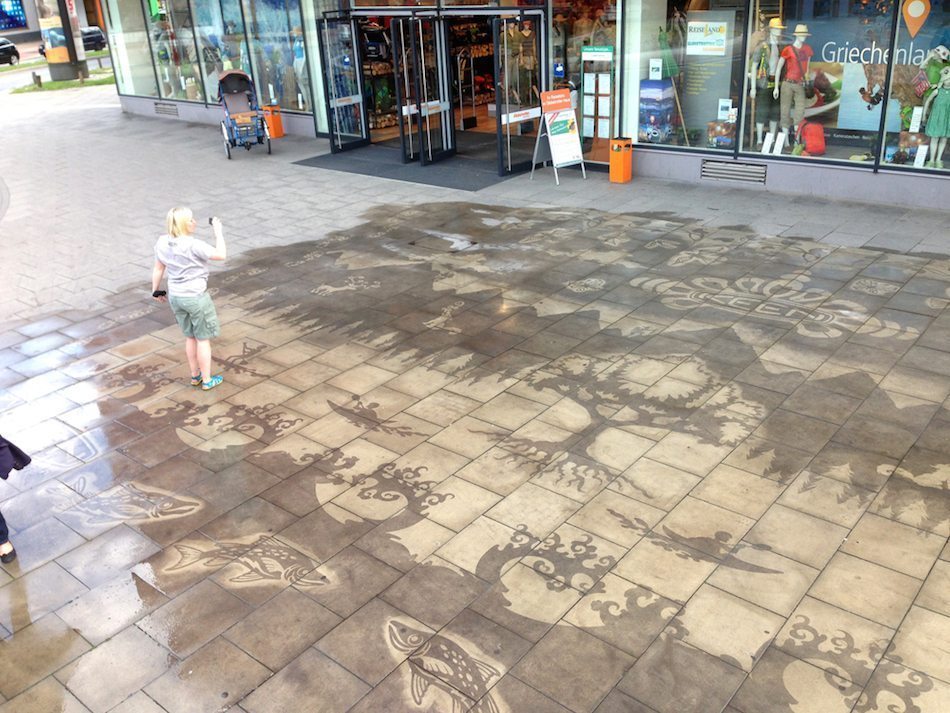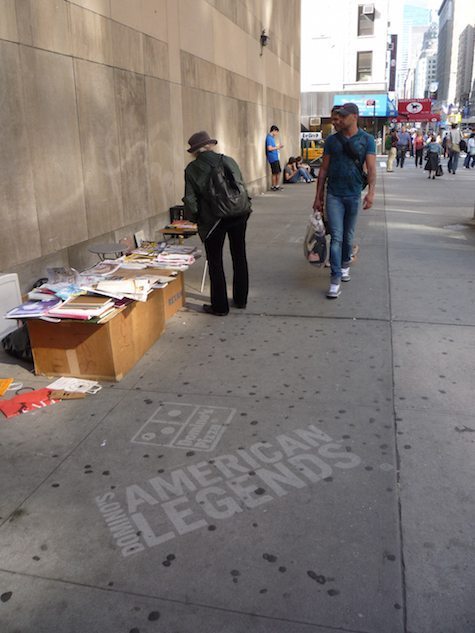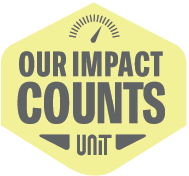Reverse Graffiti: Outdoor Advertising Without The Waste
By Jim Bowes, Guest Blogger | September 2, 2015
Each week in Europe, outdoor advertising consumes 3 million square meters of paper (over 32 million square feet). If a year’s worth of these outdoor ads were taped together to form a single sheet of paper one meter wide, it would wrap around the planet 3.9 times. This doesn’t even include billboards printed on vinyl using aggressive solvent-based inks or the new plastic films being used in place of paper.
Outdoor ad paper is so saturated with inks that it cannot be recycled, so it either ends up in a landfill or incinerated. An ad’s average life cycle? Only 12 days.
It’s clear from these numbers that outdoor advertising has an enormous negative impact on our planet. For companies serving the triple bottom line, this presents a unique problem: we know that we need to promote our brands, but doing so through these channels conflicts directly with our values. Even companies highly regarded by the eco-conscious community like Unilever and Ben & Jerry’s have yet to tackle this conundrum.
Luckily, mother nature is a fantastic brush and our urban landscape is the perfect canvas. Using natural media, businesses can communicate in ways that get attention and demonstrate their authentic commitment to their values.
Natural media is not perfect. It is not 100% eco-friendly. Still, it’s not hard to understand that water, sand, moss, mud, chalk, milk paint and the like are less harmful mediums: they don’t require manufacturing, they don’t end up in a landfill and they don’t rely on harsh solvents and other chemicals.
Natural media is a collection of old techniques that are being used in new ways and in this blog series, I’ll introduce you to the techniques I like best. I think it’s fitting to use part one to discuss the most popular technique and the one that started it all: reverse graffiti.
Sign Up for Pegable Post to get ideas, advice and resources on activating your Purpose sent right to your inbox.
Reverse Graffiti — What is It?
Reverse graffiti, also known as clean advertising, is a form of street art and if you’ve ever written “Wash Me!” on a dirty car, you’ve already used it as a form of communication. The method uses clean water, a template made from recycled materials and a power-washer to literally clean messages out of the dirt. It requires no ink, no paper, no vinyl and no electricity to front or backlight the messages so it generates very little waste.
Water is precious and using it to create ads may seem a like a huge waste, but in truth a reverse graffiti message uses around 10% of the amount of water used to produce a piece of paper comparable in size. Even better, many of the companies using this technique are funding water projects in regions where clean drinking water is scarce.
Its minimal use of resources makes using reverse graffiti a natural and authentic way to live your values and capture attention. Furthermore, documenting the story of your project creates sharable digital content that can reach a much wider audience and continue to generate attention for years to come.
Here are four great examples of reverse graffiti campaigns where advertisers understood that potential and made the most of it.
Reverse Graffiti In Action
Green Works
When Green Works wanted to drive awareness about their new line of cleaning products, they turned to one of the fathers of the modern reverse graffiti movement – Paul “Moose” Curtis. Together, they created a mural on the wall of the Broadway tunnel in San Francisco. The mural itself was stunning, and capturing its creation in this beautifully directed video, which resulted in over 1.5 million views!
Green Works also took photos that have been featured on thousands of blogs and are still being shared six years later. Ultimately, a campaign that cost less than $50,000 has generated millions of dollars of exposure.
KEEN Footwear
Nol Gerritse, head of marketing for KEEN Europe, worked with GreenGraffiti to produce a 130 square meter sidewalk mural in front of two GlobeTrotter stores. They also captured the execution on video and took tons of photos during the four hours it took to produce the sidewalk mural. Hundreds of passersby stopped to watch as the artwork emerged from the dirt, taking their own photos and videos to share on social media. The local and national press also picked up the story, exponentially expanding the reach of KEEN’s campaign. An investment of less than 20,000 euros resulted in what KEEN called their “best outdoor promotional campaign in 2013.”

Stencil art created by Drew Brophy Street Art. Executed by Jim Bowes.
Dominos Pizza
 Dominos Pizza is not known for being a sustainable company, but that didn’t stop them from using reverse graffiti to produce a small campaign consisting of 70 images in four US cities. Participants posted a picture of themselves with the ad for the chance to win a slice of pizza. Imagine people going out to find, photograph and post an image of an ad! Combined with a little PR outreach to get the ball rolling, the reverse graffiti campaign produced 25 million online impressions in the first 3 months.
Dominos Pizza is not known for being a sustainable company, but that didn’t stop them from using reverse graffiti to produce a small campaign consisting of 70 images in four US cities. Participants posted a picture of themselves with the ad for the chance to win a slice of pizza. Imagine people going out to find, photograph and post an image of an ad! Combined with a little PR outreach to get the ball rolling, the reverse graffiti campaign produced 25 million online impressions in the first 3 months.
The Secrets to Success
Not every reverse graffiti campaign gets these results, but those that do use a similar formula. They:
- Do something new and spectacular;
- Collect images, stories and videos to repurpose on other channels; and
- Use their sustainable values to appeal to consumers.
At the end of the day, fascination with the novelty of the outreach and shared sustainable values led consumers to act as brand ambassadors and share these messages.
Big Rewards & Big Risks
Reverse graffiti is easy to do and very affordable. For a few hundred dollars, any company can produce a template, rent some equipment and create its own campaigns. Before you go rent a power washer though, there are a few things you should consider.
When you use the public space as your advertising canvas, you are monetizing something that belongs to everyone. Municipalities are still grappling with what to do when this happens.
On one hand, it supports local sustainability goals and allows smaller businesses to promote themselves without paying for pricey traditional media. On the other hand, the practice isn’t controlled and regulated. Due to this tension, municipalities rarely issue permits for these projects. In many cases, permits don’t even exist!
Natural media is a new idea that’s bumping up against old rules. Although there’s no reason that local governments shouldn’t embrace it, many have proved slow to do so and at this rate, it will take years before they decide if it will be allowed and how it will be regulated. Because of this uncertainty, it takes courage to join the ranks of those running reverse graffiti campaigns.
As scary as breaking the rules can be, getting in trouble can add great value to your campaign. I’ve had clients that were disappointed they didn’t get into trouble. I’ve also had others who thanked me when they did and their story appeared on the front page of the local newspaper or all over social media. If things really get contentious, it’s easy to allay concerns – just quickly clean the messages away.
The Future
Once cities begin to see the potential of reverse graffiti, they can transform their dirty public spaces into an untapped public asset worth millions of dollars a year. They would not only generate revenue – they would create green, low-skilled jobs and take another step toward achieving their own sustainability goals.
Defining the rules of engagement will require that our cities invest some time and energy but it won’t require an investment in infrastructure – just stroll down a city street and you’ll see that dirt is everywhere. Even better, the dirty urban canvas is self-healing and will become dirty again without any effort so it can be leveraged over and over. When compensating for the water becomes part of the rules of engagement, just imagine the amount of clean drinking water we can provide for those in need.
Based on the examples above, it’s clear that outdoor advertising can be produced without having such a negative impact on our environment. By adopting natural media techniques, you can demonstrate your commitment to your values and grab attention for your message.
In the coming weeks, I’ll explore some other natural media techniques so check back if you want to learn about working with materials like sand, chalk and moss. If you have questions about reverse graffiti, feel free to reach out for advice.
*Main Image Credit: Reverse Graffiti project by Paul “Moose” Curtis at the entrance to the Robert Levy Tunnel in San Francisco. Licensed through Creative Commons; by FogCityFog.




Dear RoundPeg,
Thank you for the opportunity to write a blog about something I deeply am passionate about and something that can help companies meet their own sustainable ambitions.
Once people are made aware of the negative impact of outdoor advertising, the larger discussion can begin. I hope the readers of your blog enjoy the blog and begin to think about the alternative they can use so their advertising activities have a lower impact on our planet while having a higher impact on their audiences.
Many thanks,
Jim Bowes
Jim —
We are so lucky to have someone with your expertise writing on this topic! I know it will spark ideas for our readers and we can’t wait to see the rest of the posts in the natural media series.
Best,
Alison (+ Team!)
Hi Jim and Alison, Great article, look forward to more and would love to get some of that happening here in Australia and NZ.. cheers
Cliff http://www.goodbusinessmatters.net
Hi Cliff,
The knowledge is there. The business case is there. Now all you need is someone who wants to pick it up and run with it.
Reverse graffiti has been used in both New Zealand and Australia. Like in other countries, it remains a challenge for cities to allow it but it will happen. Wait until you see what you can do with sand! Whoof!
Feel free to contact me at any time if you have questions.
Love your company! Always delighted to see companies in the marketing industry who are embracing good business.
Thank you for your kind words!
Jim Bowes
Cliff — So glad you enjoyed reading 🙂 As Jim mentioned, he’s going to write on a few other natural media methods too so I encourage you to check back let him wow you again! ~ Alison
Hi Cliff,
Have you seen this? A local guy (Queensland) who completely understands how best to use the media and understands the concept of sustainability by using old road signs to make hi templates.
I always get excited to see people just going out and making natural media happen especially when the media is part of the messages as it is here.
http://www.abc.net.au/local/photos/2015/09/07/4307373.htm
Cheers,
Jim
Thanks Jim, great find! Will give some thought to more of the same here in Melbourne and sharing those stories..best of luck out there..Cliff
http://www.goodbusinessmatters.net